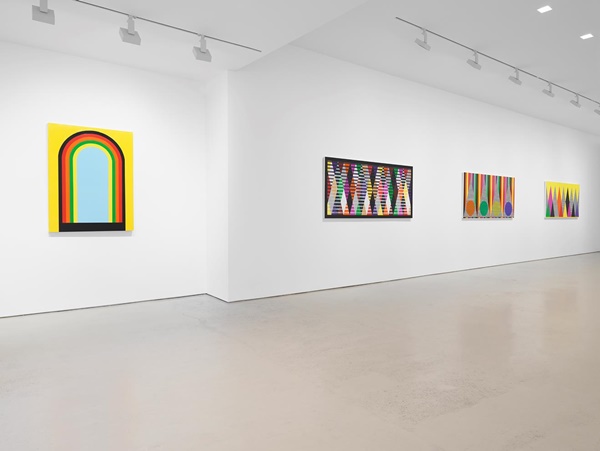Rico Gatson

MILES McENERY GALLERY
520-525 W 21nd Street New York, NY 10011Phone: 212 445 0051 e-mail:


from 28 December, 2020


Rico Gatson works across painting, sculpture, video and collage, often using abstraction as a means to explore the Black experience in America. In his show at Miles McEnery, he demonstrates how he has been able to use the same visual lexicon developed in works past to investigate Blackness in its relationship to the mystical, opening doors to see how one experience may bleed into the next. At what point does a struggle transcend the corporeal? And how are beauty and innovation possible in the midst of it all? The show’s paintings are done in acrylic on wooden, door-sized panels, and some paintings, like Untitled (Rainbow) (all works 2020), probe this metaphor of the threshold even further. Untitled (Ghosts After Albert Ayler) uses abstraction to explore how the titular jazz musician pushed sonic boundaries to their outermost extremes, with combating upright and inverted geometry that allude to the poignancy of conflicting desires—Ayler pushed beauty to its extremes, then took his own life. Also on view are a half dozen works on paper from Gatson’s ongoing Icons series, which collage images of historic Black figures amidst the artist’s sunburst-like rays. —Wallace Ludel
At Miles McEnery Gallery, a captivating exhibition by Rico Gatson revealed the power of pure abstraction to impure effect. A generation younger than the black abstractionists on view elsewhere in Chelsea, Gatson has been even more forthright in exploring the confluences of color in his work. In "Icons," a series on paper that he began in 2007, Gatson uses radiating lines to depict the power of black figures, images of whom he has affixed to the work. The series has a sonic quality that is all horn, a tone well represented in a recent retrospective at The Studio Museum in Harlem. In the latest exhibition, Miles McEnery Gallery presented a selection of them. More are now on permanent display as art-in-transit mosaics in the 167th Street subway station.
In his abstractions, Gatson has tended to work with pan-African patterns and colors. The merging of modernism and Africanism is one that groundbreaking artists such as Aaron Douglas pioneered a century ago. Of course, one may even say that modernism itself represents a confluence of African and European artistic traditions.
Through his new abstractions at Miles McEnery, Gatson seemed freer than before in going his own way, unencumbered by particular references to time and place. His geometric arrangements of circles, lines, and triangles were like radiant peaks atop mystical mountains. The graphic excitement of his earlier work is still here, just now made personal. After fifteen years of depicting famous icons, this time the iconography is his own.
At Miles McEnery Gallery, a captivating exhibition by Rico Gatson revealed the power of pure abstraction to impure effect. A generation younger than the black abstractionists on view elsewhere in Chelsea, Gatson has been even more forthright in exploring the confluences of color in his work. In "Icons," a series on paper that he began in 2007, Gatson uses radiating lines to depict the power of black figures, images of whom he has affixed to the work. The series has a sonic quality that is all horn, a tone well represented in a recent retrospective at The Studio Museum in Harlem. In the latest exhibition, Miles McEnery Gallery presented a selection of them. More are now on permanent display as art-in-transit mosaics in the 167th Street subway station.
In his abstractions, Gatson has tended to work with pan-African patterns and colors. The merging of modernism and Africanism is one that groundbreaking artists such as Aaron Douglas pioneered a century ago. Of course, one may even say that modernism itself represents a confluence of African and European artistic traditions.
Through his new abstractions at Miles McEnery, Gatson seemed freer than before in going his own way, unencumbered by particular references to time and place. His geometric arrangements of circles, lines, and triangles were like radiant peaks atop mystical mountains. The graphic excitement of his earlier work is still here, just now made personal. After fifteen years of depicting famous icons, this time the iconography is his own.
 |
Rico Gatson |








